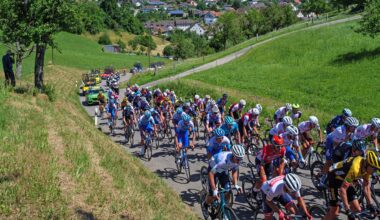How to Incorporate Speed Workouts Safely into Your Running Routine
Speed workouts are essential for improving overall running performance and increasing race times. However, safely incorporating them into your routine requires careful planning and attention to detail. First, assess your current fitness level to ensure you’re ready for speed work. If you’re new to running, building a solid aerobic base before doing speed workouts is crucial. Begin with regular runs at a comfortable pace, gradually increasing your distance and endurance. Once you feel confident, you can start adding speed workouts to improve your running economy. These workouts include intervals, tempo runs, and fartleks. Each type serves a specific purpose in enhancing speed. Proper warm-up and cooldown are vital to prevent injuries. Before starting any speed session, a dynamic warm-up can prepare your muscles. Similarly, post-workout stretches and cooldown help with recovery. Always listen to your body during these sessions. If you experience pain or discomfort, it’s essential to back off or reassess your approach. By staying aware of your limits, you can safely enhance your speed and overall performance over time.
Incorporating speed workouts into your running routine can lead to significant improvements, but they must be performed correctly. One fundamental aspect is choosing the right type of training schedule. Most runners benefit from incorporating speed work once or twice a week. This frequency allows you to focus on quality while minimizing injury risk. It’s best to avoid cramming too many speed workouts close together, as fatigue can set in. Instead, integrate a mixture of recovery runs and easy days between high-intensity workouts. Track your progress to identify what works best for you, maintaining a training log. This practice not only documents your workouts but also helps in recognizing patterns in your performances. Aim for a combination of belt runs, sprints, and longer tempo runs, as they each target various components of speed. Also, vary the intensity between these sessions. Incorporation of cross-training activities like cycling and swimming can also aid in enhancing speed without overloading your running-specific muscles. These methods foster cardiovascular improvements and overall balance in your fitness program, producing a holistic approach to speed development.
The Importance of Recovery
Recovery is often overlooked but is a vital part of any running training plan, especially when incorporating speed workouts. Speed work places additional stress on muscles, joints, and tendons, leading to fatigue. Therefore, including recovery periods is essential for optimal improvements and injury prevention. Active recovery days, which can include easy-paced runs or cross-training, allow your body to rebuild while still being active. Consider incorporating rest days into your weekly schedule to let your body fully recover from intense workouts. During these rest days, it might also be beneficial to engage in stretching and mobility exercises. This can aid muscle recovery and improve flexibility. Additionally, proper nutrition plays a pivotal role in recovery. Consuming nutrient-dense foods that include proteins, healthy fats, and carbohydrates post-workout can accelerate healing and support muscle repair. Proper hydration is equally essential for recovery. Aim to hydrate adequately before, during, and after your workouts, as this can significantly impact your performance and recovery rates over time. By prioritizing recovery, you’ll be more prepared for your upcoming workouts, ultimately facilitating better performance.
In addition to physical recovery, mental recovery is equally important. Speed workouts can be mentally taxing due to their intensity, creating an emotional response that can influence your overall performance. Incorporating mindfulness techniques, such as visualization and focused breathing, can help in stress management during these sessions. Consider setting realistic goals that motivate you but remain within your skill set. For instance, aim for gradual improvements rather than immediate drastic changes. This helps in tracking progress and ensures a balanced approach to speed development. Attending running workshops or engaging with fellow runners may also provide valuable insights and encouragement. Having a supportive community boosts your motivation and accountability throughout your training. Setting up a partnership with a running buddy can help you stay committed while tackling speed workouts together. Furthermore, recording your successes, no matter how small, can foster a positive mindset and enable you to celebrate progress. By blending physical training with mental strategies, you’ll be more resilient during challenging speed workouts, securing overall success in your running journey.
Understand the Different Types of Speed Workouts
A variety of speed workouts can be added to your running regimen, each one targeting specific components of running speed. Intervals are short bursts of high-intensity running followed by recovery periods. This format enhances your anaerobic capacity and improves your VO2 max. Tempo runs, on the other hand, are sustained efforts at a comfortably hard pace, aimed at building speed endurance through prolonged work. Fartlek training incorporates varying speeds during a continuous run, providing a fun way to mix intensity levels without strict timing. Hill repeats can also be an excellent addition, effectively building strength and power in your legs. By running uphill, you engage different muscle fibers, providing a valuable workout shift. When implementing these workouts, always remember to adhere to the 10% rule when increasing intensity or volume. This principle suggests no more than a 10% increase in mileage or intensity per week. By gradually incorporating these workouts, you can assess what works best for your body while minimizing the risk of injury and ensuring progression.
Additionally, monitoring your performance is essential to gauge your speed workout effectiveness. Utilize a running watch or app that tracks your times and distances, noting improvements after each workout. Measuring your heart rate and perceived exertion can also inform you if you’re training within the correct intensities. Utilizing data aids in adjusting your approach, allowing you to refine your training. Other factors to consider include environmental conditions. Weather can significantly impact speed, especially when exercising in heat or humidity. On hot days, it’s crucial to reduce your overall intensity to prevent overheating and maintain safety. Choose appropriate running gear to ensure comfort during speed workouts. Breathable clothing and well-fitted shoes are vital components to enhance performance and reduce distractions from discomfort. Ensure your running surfaces are safe too; soft surfaces like tracks or trails can help minimize impact during speed work. This way, you promote safe practices while maximizing your potential benefits from each speed session, fostering a healthy relationship with your running.
Adapting Your Speed Workouts
Lastly, continuously adapt your speed workouts as your fitness improves. Regular evaluations of your level of fitness allow you to make informed decisions about future training. You may need to change your workout structure to keep challenging yourself and stimulating your progress. As your endurance builds, consider increasing the distance of your interval sessions or experimenting with different speeds during tempo runs. Changing up your running routes can also provide new physical and mental challenges. Running in varied terrains enhances neuromuscular adaptations and can maintain your enthusiasm in workouts. Listen to your body and adjust your speed workouts accordingly to achieve the best results. If fatigue becomes evident, don’t hesitate to modify your routine by reducing intensity or increasing recovery time. Remember that sustainability in training is crucial to any athletic journey. When speed workouts feel routine rather than challenging, reassess and introduce some novelty into your sessions. Small changes can lead to significant improvements over time, ensuring you endure progress and enjoy your running journey while enhancing your speed effectively.
In conclusion, safely incorporating speed workouts into your running regimen requires dedication, understanding, and adaptability. Remember the importance of a solid warm-up and cooldown approach, effective monitoring of workouts, and prioritizing recovery. Always remain conscious of your personal limits, and consult with professionals when unsure about your workout plans or recovery strategies. With the right mindset and techniques, speed workouts can elevate your performance and rekindle your love for running. Revisit your goals regularly to ensure they are still aligned with your current fitness and motivation levels. Community-driven insights will help you stay rooted in healthy practices, encouraging both personal and collective growth. Embrace the challenge, enjoy the progress, and continue refining your strategies for speed work through focus and dedication. Lastly, never forget to celebrate your achievements, both big and small. This approach will keep you engaged in your running journey and motivated in your relentless pursuit of speed. Happy running and best of luck as you embrace speed workouts in your training!


